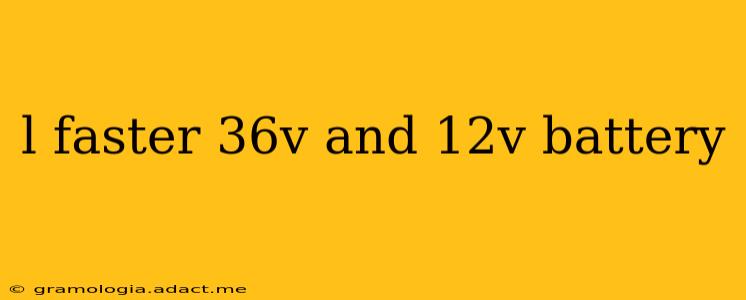Understanding 36V and 12V Battery Systems: Speed, Power, and Applications
Choosing between a 36V and a 12V battery system often comes down to the application and the desired performance. While both are commonly used in various devices, their voltage differences translate to significant variations in power output and, in some cases, speed. This article will delve into the distinctions between these two voltage systems, addressing common questions and clarifying their respective uses.
What determines the speed difference between 36V and 12V systems?
The speed difference isn't directly tied to the voltage alone but rather to the power delivered by the system. A higher voltage (like 36V) allows for greater power delivery with the same current. Consider an electric motor: a 36V system can drive a motor more forcefully, leading to increased speed and torque compared to a 12V system driving a similar motor. However, the motor's design itself plays a crucial role; a powerful motor designed for 36V will inherently be faster than a smaller, 12V motor, even if the current is the same. The key takeaway is that higher voltage enables higher power and, consequently, often faster operation, but it's not the only factor.
Which battery type is better for electric scooters, bikes, or other electric vehicles?
For electric scooters and bikes, the 36V battery system is generally preferred. The increased power output provides a more substantial boost for hill climbing and a higher top speed. The higher voltage also allows for the use of more powerful motors, resulting in a significantly more dynamic riding experience. However, 12V systems are employed in some smaller, less powerful electric vehicles, often those intended for children or very short-range transportation. The choice depends on the vehicle's intended use and the desired performance level.
Can a 36V battery be used in a 12V system?
No, directly connecting a 36V battery to a 12V system is extremely dangerous and can cause irreversible damage to the 12V components. The higher voltage will overload and potentially destroy the circuitry designed to handle only 12V. Conversely, a 12V battery cannot power a system designed for 36V. Voltage conversion using a step-down converter might be possible for certain applications but requires careful selection of the appropriate converter with sufficient capacity to avoid overheating or failure. This is a technically demanding process and should only be attempted by someone with electronics expertise.
What are the common applications for 36V and 12V batteries?
12V Batteries: These are commonplace in automotive applications, powering essential systems like headlights, ignition, and accessories. They also find use in various smaller devices, such as power tools, toys, and some security systems.
36V Batteries: These are popular in e-bikes, e-scooters, and other electric vehicles requiring greater power and speed. They are also increasingly used in some power tools and industrial equipment.
What are the safety precautions when using 36V and 12V batteries?
Always handle batteries with care. Avoid short-circuiting the terminals, which can generate intense heat and cause fires. Use appropriate chargers and ensure the battery is correctly matched to the voltage of the device. Never attempt to modify or disassemble batteries unless you have the necessary expertise. Improper handling can lead to serious injury or property damage. Consult the manufacturer's instructions for safe operation and maintenance.
In conclusion, the choice between a 36V and a 12V battery hinges heavily on the power requirements of the intended application. While 12V is suitable for low-power devices, 36V systems provide a significant power advantage, especially for electric vehicles requiring greater speed and torque. Understanding the limitations and safety considerations associated with each voltage level is paramount for safe and effective use.
